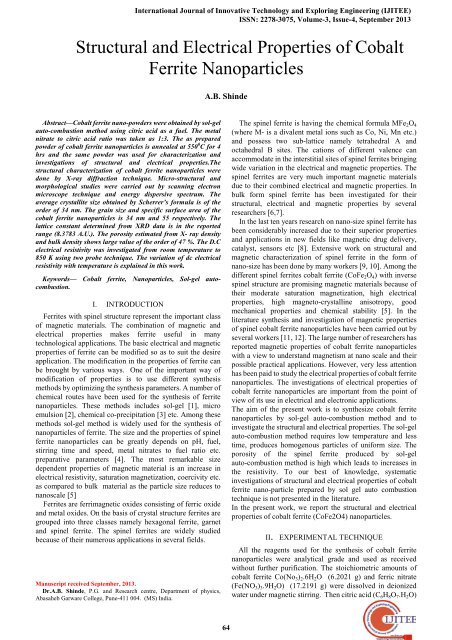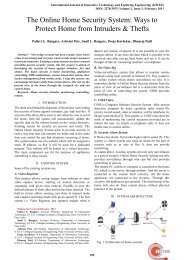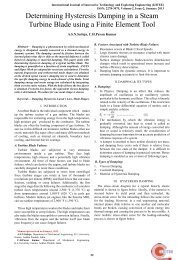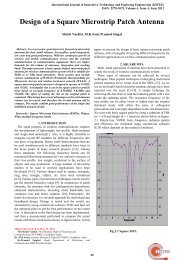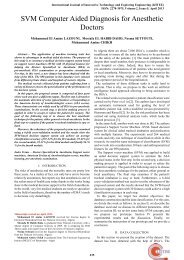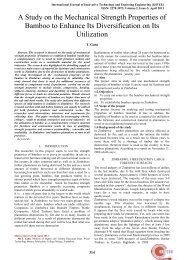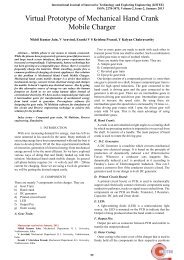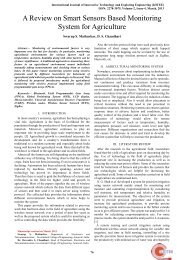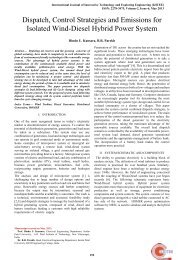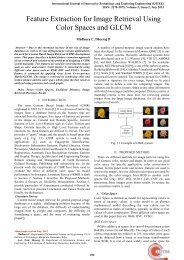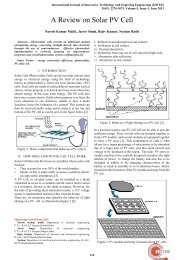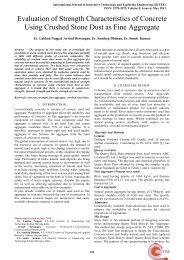Structural and Electrical Properties of Cobalt Ferrite Nanoparticles
Structural and Electrical Properties of Cobalt Ferrite Nanoparticles
Structural and Electrical Properties of Cobalt Ferrite Nanoparticles
You also want an ePaper? Increase the reach of your titles
YUMPU automatically turns print PDFs into web optimized ePapers that Google loves.
International Journal <strong>of</strong> Innovative Technology <strong>and</strong> Exploring Engineering (IJITEE)ISSN: 2278-3075, Volume-3, Issue-4, September 2013<strong>Structural</strong> <strong>and</strong> <strong>Electrical</strong> <strong>Properties</strong> <strong>of</strong> <strong>Cobalt</strong><strong>Ferrite</strong> <strong>Nanoparticles</strong>A.B. ShindeAbstract—<strong>Cobalt</strong> ferrite nano-powders were obtained by sol-gelauto-combustion method using citric acid as a fuel. The metalnitrate to citric acid ratio was taken as 1:3. The as preparedpowder <strong>of</strong> cobalt ferrite nanoparticles is annealed at 550 0 C for 4hrs <strong>and</strong> the same powder was used for characterization <strong>and</strong>investigations <strong>of</strong> structural <strong>and</strong> electrical properties.Thestructural characterization <strong>of</strong> cobalt ferrite nanoparticles weredone by X-ray diffraction technique. Micro-structural <strong>and</strong>morphological studies were carried out by scanning electronmicroscope technique <strong>and</strong> energy dispersive spectrum. Theaverage crystallite size obtained by Scherrer’s formula is <strong>of</strong> theorder <strong>of</strong> 34 nm. The grain size <strong>and</strong> specific surface area <strong>of</strong> thecobalt ferrite nanoparticles is 34 nm <strong>and</strong> 55 respectively. Thelattice constant determined from XRD data is in the reportedrange (8.3783 A.U.). The porosity estimated from X- ray density<strong>and</strong> bulk density shows large value <strong>of</strong> the order <strong>of</strong> 47 %. The D.Celectrical resistivity was investigated from room temperature to850 K using two probe technique. The variation <strong>of</strong> dc electricalresistivity with temperature is explained in this work.Keywords— <strong>Cobalt</strong> ferrite, <strong>Nanoparticles</strong>, Sol-gel autocombustion.I. INTRODUCTION<strong>Ferrite</strong>s with spinel structure represent the important class<strong>of</strong> magnetic materials. The combination <strong>of</strong> magnetic <strong>and</strong>electrical properties makes ferrite useful in manytechnological applications. The basic electrical <strong>and</strong> magneticproperties <strong>of</strong> ferrite can be modified so as to suit the desireapplication. The modification in the properties <strong>of</strong> ferrite canbe brought by various ways. One <strong>of</strong> the important way <strong>of</strong>modification <strong>of</strong> properties is to use different synthesismethods by optimizing the synthesis parameters. A number <strong>of</strong>chemical routes have been used for the synthesis <strong>of</strong> ferritenanoparticles. These methods includes sol-gel [1], microemulsion [2], chemical co-precipitation [3] etc. Among thesemethods sol-gel method is widely used for the synthesis <strong>of</strong>nanoparticles <strong>of</strong> ferrite. The size <strong>and</strong> the properties <strong>of</strong> spinelferrite nanoparticles can be greatly depends on pH, fuel,stirring time <strong>and</strong> speed, metal nitrates to fuel ratio etc.preparative parameters [4]. The most remarkable sizedependent properties <strong>of</strong> magnetic material is an increase inelectrical resistivity, saturation magnetization, coercivity etc.as compared to bulk material as the particle size reduces tonanoscale [5]<strong>Ferrite</strong>s are ferrimagnetic oxides consisting <strong>of</strong> ferric oxide<strong>and</strong> metal oxides. On the basis <strong>of</strong> crystal structure ferrites aregrouped into three classes namely hexagonal ferrite, garnet<strong>and</strong> spinel ferrite. The spinel ferrites are widely studiedbecause <strong>of</strong> their numerous applications in several fields.Manuscript received September, 2013.Dr.A.B. Shinde, P.G. <strong>and</strong> Research centre, Department <strong>of</strong> physics,Abasaheb Garware College, Pune-411 004. (MS) India.The spinel ferrite is having the chemical formula MFe 2 O 4(where M- is a divalent metal ions such as Co, Ni, Mn etc.)<strong>and</strong> possess two sub-lattice namely tetrahedral A <strong>and</strong>octahedral B sites. The cations <strong>of</strong> different valence canaccommodate in the interstitial sites <strong>of</strong> spinel ferrites bringingwide variation in the electrical <strong>and</strong> magnetic properties. Thespinel ferrites are very much important magnetic materialsdue to their combined electrical <strong>and</strong> magnetic properties. Inbulk form spinel ferrite has been investigated for theirstructural, electrical <strong>and</strong> magnetic properties by severalresearchers [6,7].In the last ten years research on nano-size spinel ferrite hasbeen considerably increased due to their superior properties<strong>and</strong> applications in new fields like magnetic drug delivery,catalyst, sensors etc [8]. Extensive work on structural <strong>and</strong>magnetic characterization <strong>of</strong> spinel ferrite in the form <strong>of</strong>nano-size has been done by many workers [9, 10]. Among thedifferent spinel ferrites cobalt ferrite (CoFe 2 O 4 ) with inversespinel structure are promising magnetic materials because <strong>of</strong>their moderate saturation magnetization, high electricalproperties, high magneto-crystalline anisotropy, goodmechanical properties <strong>and</strong> chemical stability [5]. In theliterature synthesis <strong>and</strong> investigation <strong>of</strong> magnetic properties<strong>of</strong> spinel cobalt ferrite nanoparticles have been carried out byseveral workers [11, 12]. The large number <strong>of</strong> researchers hasreported magnetic properties <strong>of</strong> cobalt ferrite nanoparticleswith a view to underst<strong>and</strong> magnetism at nano scale <strong>and</strong> theirpossible practical applications. However, very less attentionhas been paid to study the electrical properties <strong>of</strong> cobalt ferritenanoparticles. The investigations <strong>of</strong> electrical properties <strong>of</strong>cobalt ferrite nanoparticles are important from the point <strong>of</strong>view <strong>of</strong> its use in electrical <strong>and</strong> electronic applications.The aim <strong>of</strong> the present work is to synthesize cobalt ferritenanoparticles by sol-gel auto-combustion method <strong>and</strong> toinvestigate the structural <strong>and</strong> electrical properties. The sol-gelauto-combustion method requires low temperature <strong>and</strong> lesstime, produces homogenous particles <strong>of</strong> uniform size. Theporosity <strong>of</strong> the spinel ferrite produced by sol-gelauto-combustion method is high which leads to increases inthe resistivity. To our best <strong>of</strong> knowledge, systematicinvestigations <strong>of</strong> structural <strong>and</strong> electrical properties <strong>of</strong> cobaltferrite nano-particle prepared by sol gel auto combustiontechnique is not presented in the literature.In the present work, we report the structural <strong>and</strong> electricalproperties <strong>of</strong> cobalt ferrite (CoFe2O4) nanoparticles.II. EXPERIMENTAL TECHNIQUEAll the reagents used for the synthesis <strong>of</strong> cobalt ferritenanoparticles were analytical grade <strong>and</strong> used as receivedwithout further purification. The stoichiometric amounts <strong>of</strong>cobalt ferrite Co(No 3 ) 2 .6H 2 O (6.2021 g) <strong>and</strong> ferric nitrate(Fe(NO 3 ) 3 .9H 2 O) (17.2191 g) were dissolved in deionizedwater under magnetic stirring. Then citric acid (C 6 H 8 O 7 .H 2 O)64
<strong>Structural</strong> <strong>and</strong> <strong>Electrical</strong> <strong>Properties</strong> <strong>of</strong> <strong>Cobalt</strong> <strong>Ferrite</strong> <strong>Nanoparticles</strong>(13.4347 g) was mixed in the metal nitrate solution to chaletCo 2+ <strong>and</strong> Fe 3+ ions in the solution. The molar ratio <strong>of</strong> citricacid to total moles <strong>of</strong> nitrates was maintained at 1:3. A smallamount <strong>of</strong> ammonia was added drop-wise into the solution toadjust pH value to about 7 <strong>and</strong> stabilize the nitrate-citratesolution. The neutralities solution was evaporated to drynessby heating at 90 0 C on a hot plate with continuous stirring untilit becomes viscous <strong>and</strong> finally formed a very viscous gel. Thetemperature is further raised up to 120 0 C so that the ignition<strong>of</strong> the gel starts. The dried gel burnt completely in a selfpropagating combustion manner to form a lose powder.Finally the as burnt powders were annealed at temperature550 0 C for 4 hrs with a heating rate <strong>of</strong> 50 0 C per minute toobtain the spinel phase.. The structural characterization was carried out by the X-raydiffraction. XRD data were taken at room temperature usingCu-Kα (λ= 1.5406Ǻ). Scanning electron micrograph <strong>and</strong>energy dispersive spectrum were carriedD.C. electrical resistivity was measured by two probe method.A small constant voltage was applied across the sample <strong>and</strong>the current through the sample was measured with respect totemperature. Temperature <strong>of</strong> the sample in the form <strong>of</strong> pelletwas measured with chromel-alumel thermocouple.III. RESULTS AND DISCUSSIONSA. <strong>Structural</strong> <strong>Properties</strong>Figure 1 shows the powder X-ray diffraction pattern (XRD) <strong>of</strong>cobalt ferrite nano-particles. A careful examination <strong>of</strong> XRDpattern reveals the appearance <strong>of</strong> slightly broader peakssignifying the low crystallite size <strong>of</strong> the prepared samples. Allthe peak belongs to cubic spinel structure <strong>and</strong> the analysis <strong>of</strong>XRD pattern prove the formation <strong>of</strong> single phase samples.The average crystallite size was calculated using theScherrer’s formula [13] from the broadening <strong>of</strong> XRD peakcorresponding to most intense (311) peak <strong>of</strong> the XRD pattern.The crystallite size obtained from XRD data is 27 nm. Thelattice constant ‘a’ was calculated using the relation2 2 2a = dhkl h + k + l(1)where h, k, l are the Miller indices <strong>of</strong> the crystal planes <strong>and</strong>d hkl is the inter planer spacing. The lattice constant obtainedfrom XRD data is in reported range.where, M is molecular weight, N is Avogadro’s number <strong>and</strong> ais the lattice constant. The X-ray density is found to be <strong>of</strong> theorder <strong>of</strong> 5.2996 gm/cm 3 .The bulk density <strong>of</strong> cobalt ferritenano particles was measured from the Archimedes principle.The value <strong>of</strong> bulk density is <strong>of</strong> the order <strong>of</strong> 3.594 gm/cm 3 .The percentage porosity (%P) was calculated from X-raydensity <strong>and</strong> bulk density values. The porosity <strong>of</strong> cobalt ferritenanoparticle is <strong>of</strong> the order <strong>of</strong> 47 %, which is quite greaterthan that <strong>of</strong> bulk CoFe 2 O 4 [14]. The increase in porosity is dueto preparation condition [15]. The values <strong>of</strong> lattice constant,unit cell volume, molecular weight, X-ray density, bulkdensity <strong>and</strong> porosity <strong>of</strong> cobalt ferrite nano particles are givenin Table I. All the structural data <strong>of</strong> prepared cobalt ferritenanoparticles is in reported range.Figure. 2 depicts the scanning electron micrographs (SEM) <strong>of</strong>cobalt ferrite nano particles. It is observed from SEM imagethat it exhibits coral like features indicative <strong>of</strong> nano crystallinenature <strong>of</strong> the samples. Using the SEM image grain size wascalculated <strong>and</strong> the average value is given in Table II.Table. I Lattice constant (a), X-ray density (d x ),bulk density(d exp ),porosity (%p), particle size (T) for CoFe 2 O 4nanoparticles.Parametera(Å)d x(gm/cm 3 )d exp(gm/cm 3 )% PT(nm)Value 8.387 5.299 3.594 47 2711000(311)CoFe 2O 4Intensity (Arb. Unit)10000900080007000(220)(222)(400)600020 30 40 50 60 70 80(422)2 θ (degree)Fig.1 X-ray diffraction pattern for CoFe 2 O 4 nanoparticles.The X-ray density (d x ) was calculated using the relation,8Md x= (2)3Na(511)(440)Fig.2.Scanning electron micrograph <strong>of</strong> CoFe 2 O 4.Table: IIGrain Size (G), Specific surface area (S), percentage <strong>of</strong>cobalt (Co), ferric (Fe) <strong>and</strong> oxygen (O) <strong>of</strong> cobalt ferritenanoparticles obatained from SEM <strong>and</strong> EDSSr. No. Parameter Value1 Grain size(G) 34 nm2 Surface area (S) 55 m 2 /g3 Co 28.67%4 Fe 57.34%5 O 13.99%65
International Journal <strong>of</strong> Innovative Technology <strong>and</strong> Exploring Engineering (IJITEE)ISSN: 2278-3075, Volume-3, Issue-4, September 20133.83.63.43.23.0Log ρ2.82.62.42.22.01.81.2 1.3 1.4 1.5 1.6 1.7 1.81000/TFig.3. EDS Spectrum <strong>of</strong> CoFe2O4 nanoparticles.The EDS spectrum <strong>of</strong> the cobalt ferrite sample is shown infigure 3. It is evident from the Fig.3 that Co: Fe ratio is 1:2indicating that the stoichiometric proportion is maintained.Table II shows the composition <strong>of</strong> cobalt ferrite observed bythe EDS spectrum.B. <strong>Electrical</strong> <strong>Properties</strong>The electrical behavior <strong>of</strong> cobalt ferrite nanoparticles wasstudied by measuring dc resistivity as a function <strong>of</strong>temperature using two probe technique. Temperaturevariation <strong>of</strong> dc resistivity is shown in Fig. 4 It is evident fromfigure 4 that the plot <strong>of</strong> log ρ versus 1000/T exhibit the similarnature to that <strong>of</strong> bulk cobalt ferrite. It can be further observedfrom Fig.4 that resistivity decreases with increase intemperature indicating the semiconducting nature <strong>of</strong> thesamples <strong>and</strong> obeys the Arrhenius relation( )ρ = ρkT 0 e ∆E(3)where, ρ 0 is resistivity at room temperature, k is the Boltzmanconstant (8.617×10 -5 eV K -1 ), ∆E is the activation energy <strong>and</strong>T is the absolute temperature.The resistivity plot shows two regions high temperatureregion (ferrimagnetic) <strong>and</strong> low temperature region(paramagnetic) separated at a particular temperature whichmay correspond to Curie temperature <strong>of</strong> cobalt ferrite. Achange in slope is contributed to change in conductionmechanism or phase transition from ferrimagnetic toparamagnetic. The conduction mechanism can be explainedon the basis <strong>of</strong> Verwey model [16]. According to Verwey, theconduction mechanism in ferrite occurs mainly due tohopping <strong>of</strong> Fe 2+ <strong>and</strong> Fe 3+ ions in the octahedral [B] site.It is well known that hopping probability depends upon theseparation between ions <strong>and</strong> the activation energy. Theactivation energy can be determined from slope <strong>of</strong> the linearplots <strong>of</strong> dc electrical resistivity (Fig. 4) <strong>and</strong> the Arrheniusrelation [Eq. 3]. The calculated values <strong>of</strong> activation energy is<strong>of</strong> the order <strong>of</strong> 0.172 eV. The activation energy <strong>of</strong> material isassociated with mobility <strong>of</strong> charge carrier. The charge carriersare located with ions or vacant site <strong>and</strong> conduction takes placethrough hopping process.Fig.4. Temperature variation <strong>of</strong> dc resistivity <strong>of</strong>nanocrystalline cobalt ferriteIV. CONCLUSIONSOn the basis <strong>of</strong> experimental results we can conclude thefollowing :• <strong>Cobalt</strong> ferrite nanoparticles have been successfullysynthesized at a sufficiently low temperature by sol gelauto combustion technique.• The single phase nature <strong>of</strong> the samples (CoFe2O4) wasconfirmed from X-ray diffraction data.• The particle size was calculated from the most intensepeak (311) using Schrerrer formula <strong>and</strong> is in the range <strong>of</strong>27 nm.• The structural data <strong>of</strong> the present cobalt ferrite is in thereported range, EDS spectrum reveals the presence <strong>of</strong>Co2+, Fe3+ <strong>and</strong> O2- ions in proper proportions.• The D.C. electrical resistivity decreases with increase intemperature obeying Arrhenius plot.• The activation energy calculated from D.C electricalresistivity versus temperature is <strong>of</strong> the order <strong>of</strong> 0.172 eV.REFERENCES[1] A.V. Kadu, S.V. Jagtap <strong>and</strong> G.N. Chaudhari, “Studies on thepreparation <strong>and</strong> ethanol gas sensing properties <strong>of</strong> spinelZn0.6Mn0.4Fe2O4 nanomaterials” Current Applied Physics 9 (2009)1246–1251.[2] H. Nathani, S. Gubbala, <strong>and</strong> R.D.K. Misra , “Magnetic behavior <strong>of</strong>nanocrystalline nickel ferrite Part I. The effect <strong>of</strong> surface roughness”Materials Science <strong>and</strong> Engineering B 121 (2005) 126–136.[3] M.R. Anantharaman, S. Jagatheesan, K.A. Malini, S. Sindhu, A.Narayanasamy, C.N. Chinnasamy, J.P. Jacobs, S. Reijne, K. Seshan,R.H.H. Smits <strong>and</strong> H.H. Brongersma, “On the magnetic properties <strong>of</strong>ultra-fine zincferrites” Journal <strong>of</strong> Magnetism <strong>and</strong> Magnetic Materials189 (1998) 83-88.[4] Rudraji B. Tangsali Satish H. Keluskar Ganpat K. Naik Æ J. S.Budkuley, Shenoy, S.D., Joy, P.A. <strong>and</strong> M.R. Anantharaman (2004).“Effect <strong>of</strong> mechanical milling on the structural, magnetic <strong>and</strong>dielectric properties <strong>of</strong> coprecipitated ultrafine zinc ferrite” Journal <strong>of</strong>Magnetism <strong>and</strong> Magnetic Materials (269) 217-226.[5] Mukta V. Limaye, Shashi B. Singh, Sadgopal K. Date,DeeptiKothari, V. Raghavendra Reddy, Ajay Gupta,Vasant Sathe, RamJane Choudhary, <strong>and</strong> Sulabha K. Kulkarni. “High coercivity <strong>of</strong> oleicacid CoFe2O4 nanoparticles at room temperature” J. Phys. Chem. B113, (2009), 9070-9076.[6] I.C.Nlebedimn,N.Ranvah,P.I.Williams,Y.Melikhov,J.E.Snyder,A.J.Moses <strong>and</strong> D.C.Jiles, “Effect <strong>of</strong> heat treatment on the magnetic<strong>and</strong> magnetoelastic properties <strong>of</strong> cobalt ferrite” J Magn. Magn. Mater322 (2010) 1929–193366
<strong>Structural</strong> <strong>and</strong> <strong>Electrical</strong> <strong>Properties</strong> <strong>of</strong> <strong>Cobalt</strong> <strong>Ferrite</strong> <strong>Nanoparticles</strong>[7] S. S. Shinde <strong>and</strong> K. M. Jadhav, “Bulk magnetic properties <strong>of</strong> cobaltferrite doped with Si4+. Ions”, J. Mater Sci. Lett. 17 (1998) 849.[8] Sasmita Mohapatra , Smruti R. Rout , Swatilekha Maiti , Tapas K.Maiti <strong>and</strong> Asit B. P<strong>and</strong>a, “Monodispersemesoporous cobalt ferrite nanoparticles: synthesis <strong>and</strong> application intargeted delivery <strong>of</strong> antitumor drugs” J. Mater. Chem., 21 (2011)9185.[9] K. Maaz, S.Karim, A.Mumtaz, S.K.Hasanain, J.Liu, J.L.Duan,“Synthesis <strong>and</strong> magnetic characterization <strong>of</strong> nickel ferritenanoparticles prepared by co-precipitation route” J Magn. Magn.Mater. 321 (2009) 1838.[10] Y. Ichiyanagi, M. Kubota, S. Moritake, Y. Kanazawa, T. Yamada <strong>and</strong>T. Uehashi, “Magnetic properties <strong>of</strong> Mg-ferrite nanoparticles” J.Magn. Magn. Mater. 310 (2007) 2378.[11] Lawrence Kumar <strong>and</strong> Manoranjan Kar, “Influence <strong>of</strong>Al3+ionconcentration on the crystal structure <strong>and</strong> magnetic anisotropy <strong>of</strong>nanocrystalline spinel cobalt ferrite” J. Magn. Magn. Mater. 323(2011) 2042.[12] N.M. Deraz “Glycine-assisted fabrication <strong>of</strong> nanocrystalline cobaltferrite system” J. Analyt. Appl. Pyro. 88 (2010) 103–109[13] B. D. Cullity, Elements <strong>of</strong> X-ray Diffraction (Addison-Wesley,London), 1978.[14] Sagar E. Shirsath , B.G. Toksha <strong>and</strong> K.M. Jdha substitutedNiFe2O4” Mat. Chem. Phys. 117 (2009) 163-168.[15] N. M. Deraz, <strong>and</strong> A. Alarif, “ Processing <strong>and</strong> Evaluation <strong>of</strong> AluminaDoped Nickel <strong>Ferrite</strong> Nano- Particles” Int. J. Electrochem. Sci., 7(2012) 4585 – 4595[16] P. Jeppson, R. Sailer, E. Jarabek, J. S<strong>and</strong>strom, B. Anderson, M.Bremer, D. G. Grier, D. L. Schulz, <strong>and</strong> A. N. Carusoa “<strong>Cobalt</strong> ferritenanoparticles: Achieving the superparamagnetic limit by chemicalreduction” J. Appl. Phys. 100, 114324 (2006).A.B. Shinde, Presently he is working as an associate pr<strong>of</strong>essor <strong>and</strong> Head,P.G. <strong>and</strong> Research centre, Department <strong>of</strong> Physics, Abasaheb GarwareCollege, Pune-411 004. He has done his M.Sc. <strong>and</strong> M.Phil. degree in Physicsfrom Pune University, Pune. He has done his Ph.D. degree from Dr.Babasaheb Ambedkar marathwada university, Aurangabad.He has 23 yearsteaching experience at PG <strong>and</strong> UG level. He published 6 papers atinternational reputed journals <strong>and</strong> 15 papers at international <strong>and</strong> nationalconferences.67


